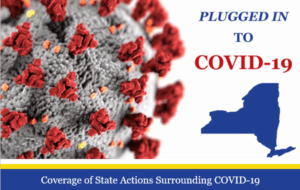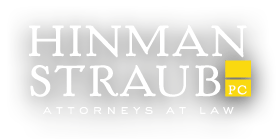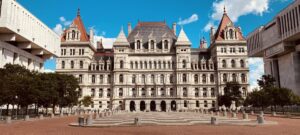Plugged In To Covid-19
March 13, 2021
 Coverage of State Actions Surrounding COVID-19
Coverage of State Actions Surrounding COVID-19
Since the emergence of SARS-CoV-2, the virus that causes coronavirus disease in late 2019, the state has been required to implement mitigation strategies, as well as provide resources for communities and institutions. To help keep clients informed and up to date on the pandemic, the Team at Hinman Straub has released Plugged In To COVID-19; a daily newsletter providing coverage of NY state actions.
What’s Inside Plugged In To COVID-19
- Governor’s Briefing and Announcements
- CMS and CDC Update Nursing Home Visitation Guidance
- Guidance on COVID-19
- Updated Links and Resources
Governor’s Briefings and Announcements on COVID-19
During his most recent conference call with media outlets, the Governor provided an update on statewide COVID-19 data and activity as of 3/11/2021. The overall statewide positivity rate is 3.11%. Statewide hospitalizations total 4,634, with ICU admissions associated with COVID-19 totaling 935, of which 639 are intubated. The Governor also confirmed that, on the previous day, 74 New Yorkers have passed away as a result of COVID-19.
The Governor announced that New York has administered over 6.2 million COVID-19 vaccines, with 1.12 million doses administered over the past seven days. Approximately 21% of residents have received their first dose, 10.7% of residents are fully vaccinated.
The Governor also announced he will sign legislation (A3988/S4681) that extends to 2022, the provision of death benefits for public employees who passed away as a result COVID-19, legislation (A3354B/S2588A) that provides public and private employees up to 4 hours of paid time off for appointments to receive the OCVID-19 vaccine, as well as legislation (A3011/S2511) which will not require the repayment of overpayments in unemployment benefits for those recipients who are experiencing financial hardship to due COVID-19.
Lastly, the Governor announced that indoor dining in New York City will increase from 35% to 50%, in line with New Jersey, beginning March 19th.
CMS and CDC Update Nursing Home Visitation Guidance
On March 10, 2021, the Centers for Medicare & Medicaid Services (CMS), in collaboration with the Centers for Disease Control and Prevention (CDC), issued revised guidance for nursing home visitation options during the COVID-19 pandemic public health emergency (PHE). This guidance is primarily intended to convey how visitation can still occur when there is an outbreak, but there is evidence that the transmission of COVID-19 is contained to a single area (e.g., unit) of the facility. The State DOH has not yet adopted this guidance.
Specifically, the CMS guidance requires that when there is a new case of COVID-19 identified among the residents or staff of a facility, a first round of outbreak testing should begin immediately and all visitation should be temporarily suspended.
- If the first round of outbreak testing reveals no additional COVID-19 cases among other areas (e.g., units) of the facility, then visitation can resume for residents in those areas/units with no COVID-19 cases. However, the facility should suspend visitation on the affected unit until the facility meets the criteria to discontinue outbreak testing.
- If first round of outbreak testing reveals one or more additional COVID-19 cases in other areas/units of the facility (e.g., new cases in two or more units), then facilities should suspend visitation for all residents (vaccinated and unvaccinated), until the facility meets the criteria to discontinue outbreak testing.
Additionally, this guidance provides that beyond one round of outbreak testing, nursing homes should continue all necessary rounds of outbreak testing, and further does not change any expectations for testing and adherence to infection prevention and control practices.
On February 23rd, the State DOH had released updated guidance on visitation in nursing homes and in comparison to the CMS revised guidance on visitation, some inconsistencies can be identified.
See also the: CMS – Nursing Home Visitation Infographic.
Guidance on COVID-19 Vaccine
Department of Health (DOH):
COVID-19 Vaccine Provider Guidance Update – Effective March 10th, the groups eligible to receive the COVID-19 vaccine are expanded to include individuals ages 60 years and older. Prior to March 17th, enrolled pharmacies must vaccinate only individuals age 60 and older, P-12 school faculty and staff, and childcare workers.
Also until March 17, FQHCs must prioritize individuals age 60 and older, then may vaccinate P-12 teachers and staff, and childcare workers, followed by all otherwise eligible adults. FQHCs receiving vaccine from the Federal program must still follow NYS guidelines for currently eligible populations.
Beginning March 17th, enrolled providers will be permitted to administer the COVID-19 vaccines to all eligible individuals, with the exception for enrolled retail pharmacies who should only vaccinate individuals 60 years and older.
Further expansion of vaccine eligibility: Effective March 17th, public-facing government and public employees, not-for-profit workers who provide public-facing services to New Yorkers in need, and essential in-person public-facing building service workers and providers of essential building services are eligible to be vaccinated.
Updated Quarantine Restrictions on Travelers to NY – This updated guidance provides the following changes.
Domestic travelers to New York may be exempt from a quarantine or “testing-out” requirements if they meet the specific criteria to be considered “fully vaccinated”; or if they are asymptomatic and were diagnosed with lab confirmed COVID-19 and have since recovered. Domestic travelers from states contiguous to New York (Pennsylvania, New Jersey, Connecticut, Massachusetts and Vermont) remain exempt from this revised guidance.
In accordance with CDC guidance, air passengers traveling to the U.S. from another country must show either documentation of having recovered from COVID-19 (and be in the 90 day window of time since) or a negative test result from no more than 3 days prior to day of travel to the airline before boarding the flight.
After arriving to the U.S., travelers must either quarantine for 7 days with a test 3-5 days after travel, or quarantine for the full 10 days without a test. This requirement applies to all international travelers whether they were tested before boarding, are recovered from a previous COVID infection, or are fully vaccinated.
Additional exemptions for the minimum 3 days quarantine after returning to New York from a non-contiguous state would apply to those teachers, school employees, and child care workers who are “fully vaccinated”.
Health care workers must follow travel guidance as outlined in the return to work guidance for healthcare workers.
Revised Return to Work Protocols for HCP – This revised guidance makes conforming updates to the prior version issued by DOH on January 7, 2021 regarding return to work protocols for health care personnel (HCP), and makes changes that align State guidance with the CDC’s updates to “Strategies to Mitigate Healthcare Personnel Staffing Shortages” and “Testing Healthcare Personnel for SARS-CoV-2” guidance issued on February 14, 2021.
DOH includes a detailed list of mitigation strategies to address HCP staffing shortages which healthcare entities should have put in place, prior to requesting DOH authorization that allows exposed HCPs to return to work early.
These highlighted mitigation strategies incorporate measures reflective of recent updates to quarantine requirements per the State’s Travel Advisory, CDC’s guidance on Testing of HCP for SARS-CoV-2, as well as measures to hire additional per diem staff and staff from other healthcare entities, asking HCP to postpone elective time off, reductions to non-essential procedures and visits in hospitals and similar settings, and utilization of asymptomatic fully vaccinated HCP or HCP who have recovered from SARS-CoV-2.
This guidance provides that asymptomatic HCP who have been fully vaccinated against COVID-19 may not need to quarantine or furlough during the first 3 months after being fully vaccinated, provided that certain criteria are met. To review the revised guidance in its entirety, click here.
Medicaid Coverage Policy and Billing Guidance – this guidance provides updated Medicaid billing and coverage information for the emergency use authorization (EUA) of the Janssen COVID-19 Vaccine.
Interim Guidance for School-Based Health Centers Regarding COVID-19 – This revised guidance is intended to further support program staff during ongoing service provision at open SBHCs, clarify guidance for changes to the status of SBHC operations, and ensure best practices for the reopening of temporarily closed clinics for onsite/in-person service provision.
Updated Guidance for School Administrators Regarding Limited Temporary Enforcement of Student Immunization Requirement – DOH has announced it will continue to exercise discretion, and will not enforce the provisions of Public Health Law § 2164(7) related to required vaccinations for students to attend school, for a period of 30 days through April 10, 2021. This will apply for students attending school exclusively through remote learning.
NY State Education Department (NYSED)
Extension of Distance Education Flexibility for the 2021-2022 Academic Year – NYSED is extending the current distance education flexibility until the end of the 2021-2022 academic year, which permits institutions to continue to offer distance education courses in programs without triggering the need to register the programs in the distance education format.
 Updated Links and Resources
Updated Links and Resources
Hinman Straub Resources:
COVID-19 Executive Orders Reference Table
New York Forward:
COVID-19 Hot Spot Zones by Address
Department of Health:
“Am I Eligible?” – Application
COVID-19 – Phased Distribution of the Vaccine
COVID-19 Vaccine Information for Providers
Information for Healthcare Providers
State Education Department


